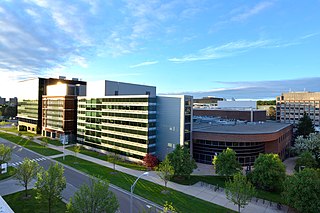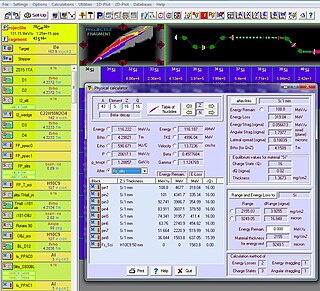Isotope separation is the process of concentrating specific isotopes of a chemical element by removing other isotopes. The use of the nuclides produced is varied. The largest variety is used in research. By tonnage, separating natural uranium into enriched uranium and depleted uranium is the largest application. In the following text, mainly uranium enrichment is considered. This process is crucial in the manufacture of uranium fuel for nuclear power plants and is also required for the creation of uranium-based nuclear weapons. Plutonium-based weapons use plutonium produced in a nuclear reactor, which must be operated in such a way as to produce plutonium already of suitable isotopic mix or grade.
A nuclear electric rocket is a type of spacecraft propulsion system where thermal energy from a nuclear reactor is converted to electrical energy, which is used to drive an ion thruster or other electrical spacecraft propulsion technology. The nuclear electric rocket terminology is slightly inconsistent, as technically the "rocket" part of the propulsion system is non-nuclear and could also be driven by solar panels. This is in contrast with a nuclear thermal rocket, which directly uses reactor heat to add energy to a working fluid, which is then expelled out of a rocket nozzle.

TRIUMF is Canada's national particle accelerator centre. It is considered Canada's premier physics laboratory, and consistently regarded as one of the world's leading subatomic physics research centres. Owned and operated by a consortium of universities, it is on the south campus of one of its founding members, the University of British Columbia in Vancouver, British Columbia, Canada. It houses the world's largest normal conducting cyclotron, a source of 520 MeV protons, which was named an IEEE Milestone in 2010. Its accelerator-focused activities involve particle physics, nuclear physics, nuclear medicine, materials science, and detector and accelerator development.

Accelerator mass spectrometry (AMS) is a form of mass spectrometry that accelerates ions to extraordinarily high kinetic energies before mass analysis. The special strength of AMS among the different methods of mass spectrometry is its ability to separate a rare isotope from an abundant neighboring mass. The method suppresses molecular isobars completely and in many cases can also separate atomic isobars. This makes possible the detection of naturally occurring, long-lived radio-isotopes such as 10Be, 36Cl, 26Al and 14C.

An ion beam is a type of charged particle beam consisting of ions. Ion beams have many uses in electronics manufacturing and other industries. A variety of ion beam sources exists, some derived from the mercury vapor thrusters developed by NASA in the 1960s. The most common ion beams are of singly-charged ions.

The ISOLDE Radioactive Ion Beam Facility, is an on-line isotope separator facility located at the centre of the CERN accelerator complex on the Franco-Swiss border. Created in 1964, the ISOLDE facility started delivering radioactive ion beams (RIBs) to users in 1967. Originally located at the Synchro-Cyclotron (SC) accelerator, the facility has been upgraded several times most notably in 1992 when the whole facility was moved to be connected to CERN's ProtonSynchroton Booster (PSB). ISOLDE is currently the longest-running facility in operation at CERN, with continuous developments of the facility and its experiments keeping ISOLDE at the forefront of science with RIBs. ISOLDE benefits a wide range of physics communities with applications covering nuclear, atomic, molecular and solid-state physics, but also biophysics and astrophysics, as well as high-precision experiments looking for physics beyond the Standard Model. The facility is operated by the ISOLDE Collaboration, comprising CERN and sixteen (mostly) European countries. As of 2019, close to 1,000 experimentalists around the world are coming to ISOLDE to perform typically 50 different experiments per year.

The Argonne Tandem Linac Accelerator System (ATLAS) is a U.S. Department of Energy scientific user facility at Argonne National Laboratory. ATLAS is the first superconducting linear accelerator (linac) for heavy ions at energies in the vicinity of the Coulomb barrier and is open to scientists from all over the world.
A radio-frequency quadrupole (RFQ) beam cooler is a device for particle beam cooling, especially suited for ion beams. It lowers the temperature of a particle beam by reducing its energy dispersion and emittance, effectively increasing its brightness (brilliance). The prevalent mechanism for cooling in this case is buffer-gas cooling, whereby the beam loses energy from collisions with a light, neutral and inert gas. The cooling must take place within a confining field in order to counteract the thermal diffusion that results from the ion-atom collisions.

The European Spallation Source ERIC (ESS) is a multi-disciplinary research facility currently under construction in Lund, Sweden. Its Data Management and Software Centre (DMSC) is situated in Copenhagen, Denmark. Its 13 European contributor countries are partners in the construction and operation of the ESS. The ESS is scheduled to begin its scientific user program in 2027, when the construction phase is set to be completed. The ESS will assist scientists in the tasks of observing and understanding basic atomic structures and forces, which are more challenging to do with other neutron sources in terms of lengths and time scales. The research facility is located near the MAX IV Laboratory, which conducts synchrotron radiation research. The construction of the facility began in the summer of 2014 and the first science results are planned for 2027.

The Proton Synchrotron Booster (PSB) is the first and smallest circular proton accelerator in the accelerator chain at the CERN injection complex, which also provides beams to the Large Hadron Collider. It contains four superimposed rings with a radius of 25 meters, which receive protons with an energy of 160 MeV from the linear accelerator Linac4 and accelerate them up to 2.0 GeV, ready to be injected into the Proton Synchrotron (PS). Before the PSB was built in 1972, Linac 1 injected directly into the Proton Synchrotron, but the increased injection energy provided by the booster allowed for more protons to be injected into the PS and a higher luminosity at the end of the accelerator chain.

FAZIA stands for the Four Pi A and Z Identification Array.
The Canadian Penning Trap Mass Spectrometer (CPT) is one of the major pieces of experimental equipment that is installed on the ATLAS superconducting heavy-ion linac facility at the Physics Division of the Argonne National Laboratory. It was developed and operated by physicist Guy Savard and a collaboration of other scientists at Argonne, the University of Manitoba, McGill University, Texas A&M University and the State University of New York.

The Facility for Rare Isotope Beams (FRIB) is a scientific user facility for nuclear science, funded by the U.S. Department of Energy Office of Science (DOE-SC), Michigan State University (MSU), and the State of Michigan. Michigan State University contributed an additional $212 million in various ways, including the land. MSU established and operates FRIB as a user facility for the Office of Nuclear Physics in the U.S. Department of Energy Office of Science. At FRIB, scientists research the properties of rare isotopes to advance knowledge in the areas of nuclear physics, nuclear astrophysics, fundamental interactions of nuclei, and real-world applications of rare isotopes. Construction of the FRIB conventional facilities began in spring 2014 and was completed in 2017. Technical construction started in the fall of 2014 and was completed in January 2022. The total project cost was $730M with project completion in June 2022.

The program LISE++ is designed to predict the intensity and purity of radioactive ion beams (RIB) produced by In-flight separators. LISE++ also facilitates the tuning of experiments where its results can be quickly compared to on-line data. The program is constantly expanding and evolving from the feedback of its users around the world.

The Soreq Applied Research Accelerator Facility (SARAF), located at the Soreq Nuclear Research Center (SNRC) in Yavne, Israel, is a multi-user and versatile particle accelerator facility based on a proton/deuteron RF superconducting linear accelerator. It has a variable energy of around 40 MeV and a continuous wave (CW) high ion current.

The Future Circular Collider (FCC) is a proposed particle accelerator with an energy significantly above that of previous circular colliders, such as the Super Proton Synchrotron, the Tevatron, and the Large Hadron Collider (LHC). The FCC project is considering three scenarios for collision types: FCC-hh, for hadron-hadron collisions, including proton-proton and heavy ion collisions, FCC-ee, for electron-positron collisions, and FCC-eh, for electron-hadron collisions.
The Laboratori Nazionali di Legnaro is one of the four major research centers of the Italian National Institute for Nuclear Physics (INFN). The primary focus of research at this laboratory is in the fields of nuclear physics and nuclear astrophysics, where five accelerators are currently used. It is one of the most important facilities in Italy for research in these fields. The main future project of the laboratory is the Selective Production of Exotic Species (SPES), in which various radionuclides will be produced for research and medicinal purposes.

CERN-MEDical Isotopes Collected from ISOLDE (MEDICIS) is a facility located in the Isotope Separator Online DEvice (ISOLDE) facility at CERN, designed to produce high-purity isotopes for developing the practice of patient diagnosis and treatment. The facility was initiated in 2010, with its first radioisotopes (terbium-155) produced on 12 December 2017.

The high-precision mass spectrometer ISOLTRAP experiment is a permanent experimental setup located at the ISOLDE facility at CERN. The purpose of the experiment is to make precision mass measurements using the time-of-flight (ToF) detection technique. Studying nuclides and probing nuclear structure gives insight into various areas of physics, including astrophysics.

The Versatile Ion polarisation Technique Online (VITO) experiment is a permanent experimental setup located in the ISOLDE facility at CERN, in the form of a beamline. The purpose of the beamline is to perform a wide range of studies using spin-polarised short-lived atomic nuclei. VITO uses circularly-polarised laser light to obtain polarised radioactive beams of different isotopes delivered by ISOLDE. These have already been used for weak-interaction studies, biological investigations, and more recently nuclear structure research. The beamline is located at the site of the former Ultra High Vacuum (UHV) beamline hosting ASPIC.















